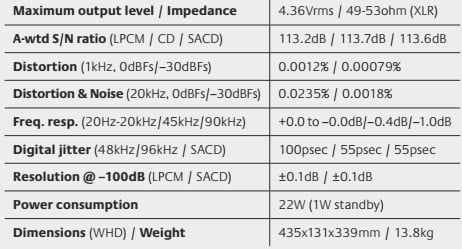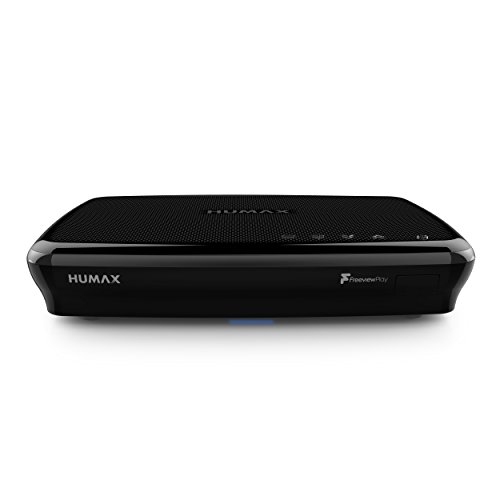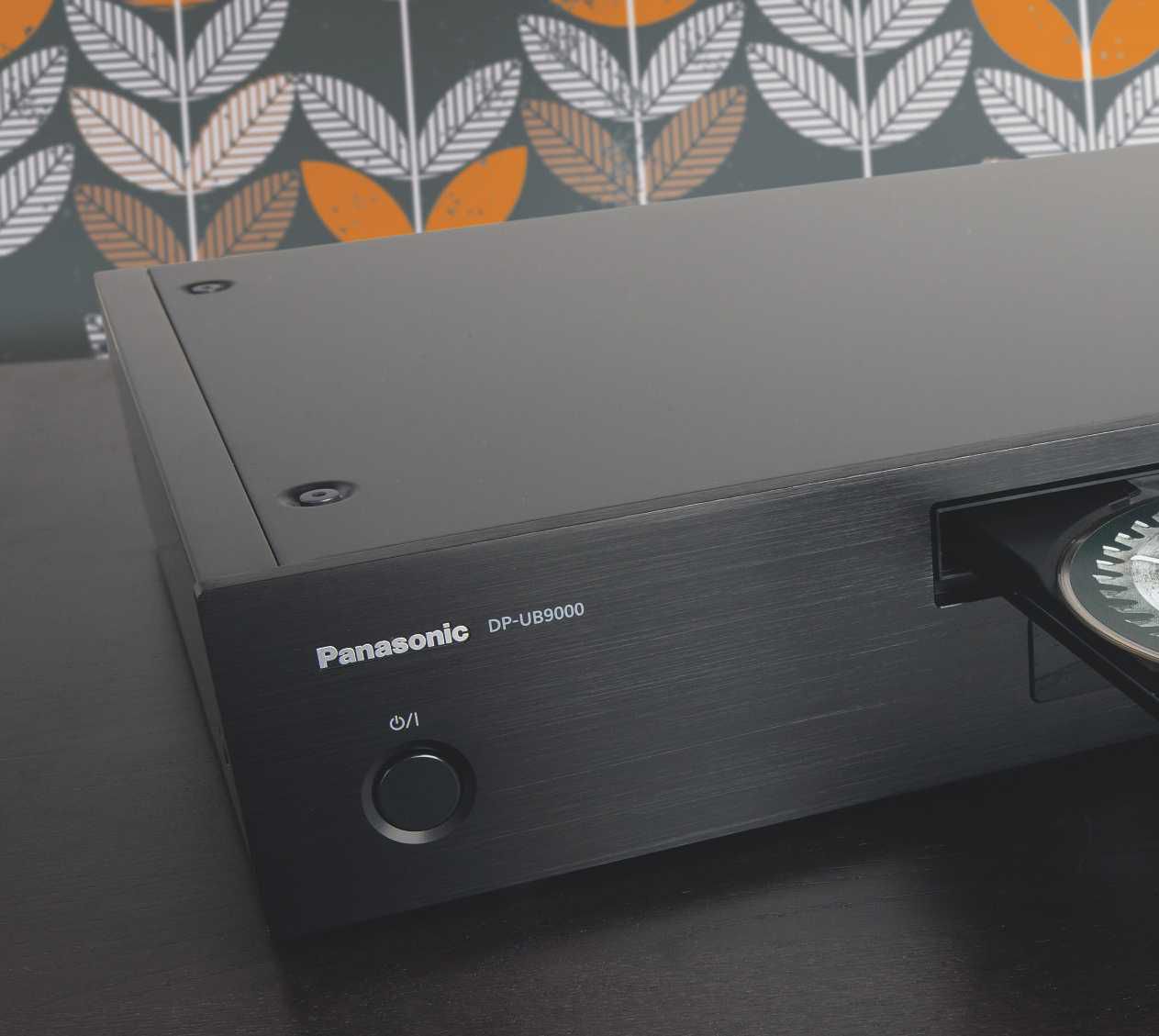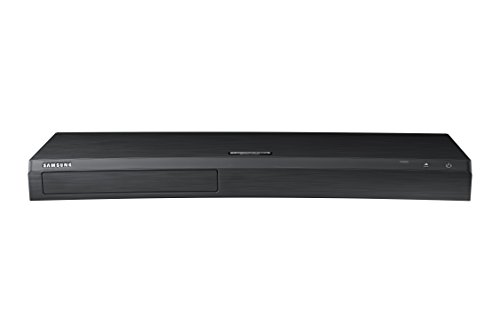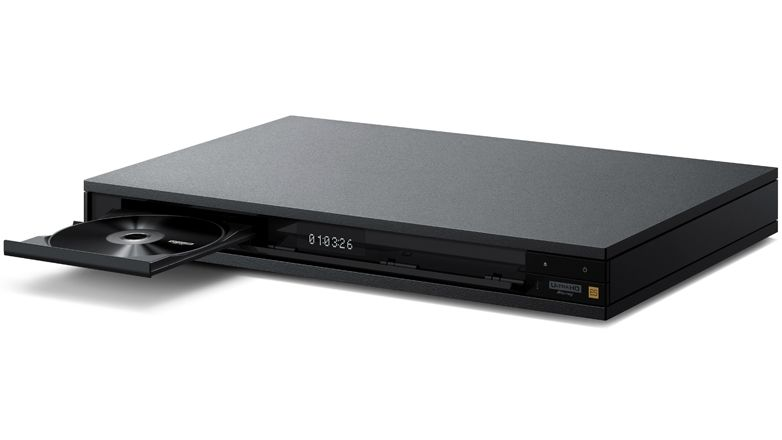Pioneer UDP-LX800 Review
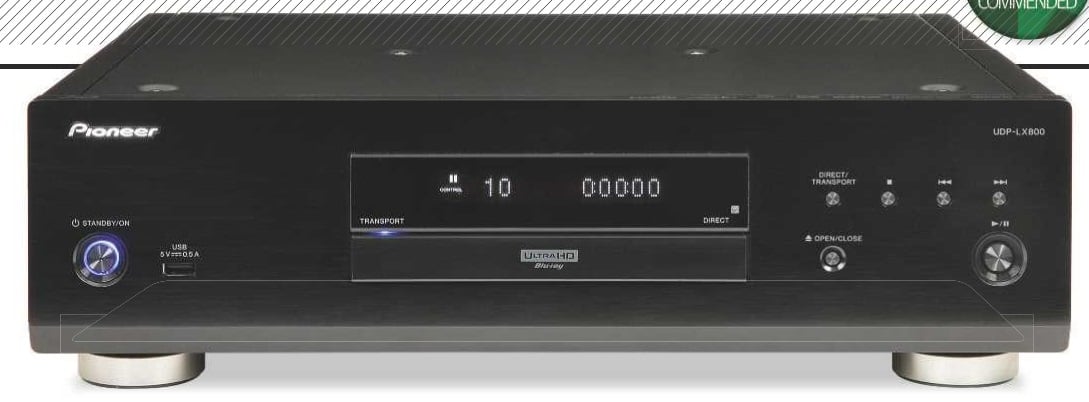
Designed for movies as well as music, the idea of a ‘universal’ disc player is an appealing one. Now that Oppo is out of the picture, how does this battleship Pioneer shape up?
Review: Andrew Everard & Steve May
Lab: Paul Miller
CD/SACD/BD player/HDD USB DAC Made by: Onkyo & Pioneer Corp., Osaka, Japan Supplied by: Pioneer & Onkyo Europe GmbH, Middlesex Telephone: 0208 836 3500
Web: www.pioneer-audiovisual.co.uk
Though maybe not for the hi-fi purists, who will look with disdain at any machine in which ultra- high-frequency video circuits are buzzing away, potentially affecting audio purity, for the pragmatist the concept of a ‘universal’ disc player is very appealing.
Table of Contents
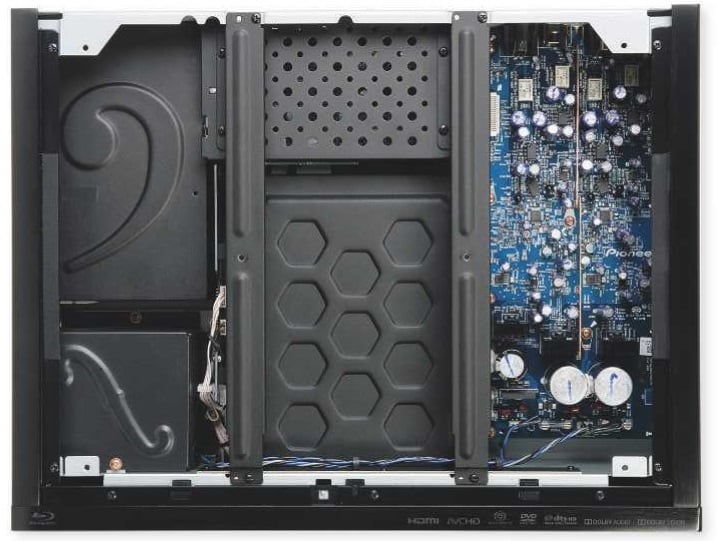
RIGHT: A purist player – equipped with two ESS9026 Pro DACs and a fully balanced analogue output, a compliantly-mounted CD/SACD/DVD/ BD drive and separate power supplies for its digital audio/video and analogue audio circuits
In one machine you can have both a piece of hardware capable of playing both CDs and SACDs – and more – and a high-quality video source for a home cinema system.
Of course the idea of a do-it-all player is nothing new: we’ve had them since Blu-ray appeared, and they brought with them the bonus of being able to play hi-res audio as well as those newfangled discs. And, of course, the late lamented Oppo Digital built its reputation on high quality video/audio players. But Pioneer’s new UDP-LX800, selling for a relatively punchy £, is about as universal as they come.
Not only does it play the latest UHD Blu-ray titles – and of course standard Blu- ray and DVD titles – but also DVD in all its flavours, from commercial video discs to recordable media, CDs and CD-R/RWs, and SACDs, too. It can also play content from USB media (pen drives and HDDs) plugged into either of the two USB Type A ports provided – one front, one rear. Moreover, its Ethernet port allows it to stream audio and video content stored on the home network, for example on a computer or a dedicated NAS unit.
A CONFESSION
Before proceeding further, something of a confession: although I used to write about both audio and video systems in a previous life, and indeed still have a pretty good Blu-ray player, AV receiver and large-screen TV, I’m finding it hard to remember the last time I actually sat down and watched a movie. So those readers who want to discover if, and how, the ’LX800 cuts the filmic mustard should turn to our boxout [p45] written by HT expert, Steve May.
But back to HFN’s core subject: the highest quality hi-fi. The UDP-LX800 certainly seems to have the wherewithal to compete in this ballpark, offering both conventional RCA and balanced XLR outputs, while playback from USB media and network sources goes right up to 192kHz/24-bit and DSD128/5.6MHZ, both in stereo and 5.1-channel surround. Incidentally, playing surround audio is achieved via the HDMI output, the analogue outs being stereo only, so you’ll need to factor in the cost of a multichannel processor or DAC if you want to take advantage of audio-only surround.
But if you have a surround set-up, as I do, then you’ll quite possibly already have an AV receiver able to accept audio from the ’LX800 over HDMI. This is how I hooked up the player for surround duty, with connections for two-channel listening direct to my main hi-fi system from the player’s analogue outs.
The UDP-LX800 has two HDMI outputs: a main one carrying both audio and video, designed for connecting to the TV, and a second only carrying audio. It’s also worth noting that if you use a compatible Pioneer AV receiver, the company’s PQLS (Precision Quartz Lock System) technology comes into play, essentially slaving the player’s master clock to that in the receiver over the HDMI link, for lower jitter. This system alters its operation to suit the signal being sent, with separate modes for two-channel music from CD, multichannel from Blu-ray, or a bitstream, for example from SACDs.
ON-SCREEN MENU
One disadvantage of combined AV players is that much of the set-up navigation and operation relies on on-screen information and feedback. For example, the UDP-LX800 has switchable digital filters, accessed via a button on the remote control, but best viewed as part of its ‘Audio Parameters’ on-screen menu. For those not wanting, or unable to use the player with a full-size screen, it’s possible to add a compact monitor, which will set you back less than £ from that site named after a South American river.
The filters, incidentally, are described as ‘Sharp’, ‘Short’ and ‘Slow’, and are applicable only to the analogue outputs. However, when the player is used in its ‘Direct’ or ‘Transport’ modes, the former of which switches off the video and digital outputs for the purest possible sound, these settings aren’t available. I have to say that I found the ‘Short’ and ‘Slow’ settings a little too soft and lazy – especially the latter – and opted for the traditional ‘Sharp’ (roll-off) linear phase filter as my default.
HIDDEN TOUCHES
As our inside view shows [opposite], the ’LX800 may be a multifunctional machine, but its design and build is both modular and compartmentalised. The circuitry is split into three blocks – power supply, analogue audio and everything else –
‘It dispels the old “home cinema gear is rubbish at music” myth’
with the transport mechanism floated to minimise vibration ingress, mounted in an enclosure stamped into a honeycomb pattern for greater rigidity and with further damping for the disc-tray. The whole player is built for solidity and rigidity, with a hefty 3mm steel plate under the 1.6mm-thick chassis to reinforce things and lower the centre of gravity, while the casework is solid metal with alloy side panels, and no vents to weaken the structure.
A nice touch, although invisible to the user, is the wit shown within the player. The power transformer is in a copper-plated housing pressed with a pattern evoking the f-shaped holes in a string instrument’s soundboard, this embossing increasing rigidity while also breaking up the flat surface to combat standing waves. Meanwhile the housing for the power supply circuitry is in a similar anti-vibration case, this time embossed with a bass clef.
All of that contributes to what is an unusually hefty machine. So it may look like

ABOVE: For all the flexibility, the front panel is kept simple and clean, but note port to the left for playback from USB storage, and signal-path- simplifying ‘Direct/Transport’ button
any other Pioneer player, if a little on the large side at some 13cm tall, but anyone expecting something rather tinny is going to be disappointed. In practice, the UDP- LX800 weighs an impressive 13.8kg, which is well up into hi-fi amplifier territory, let alone a disc-player.
PROVEN PEDIGREE
Pioneer makes no secret of the fact that the analogue audio section here is derived from its flagship PD-70AE SACD/CD player [HFN May ’18], right down to identical signal paths for each channel. However, with that player being even larger and more heftily built, and this ‘universal’ machine selling for the same money despite the addition of all the UHD video, USB inputs and network audio functionality, surely there’s been some ‘give’ in terms of pure audio performance?
The answer to that is definitely a yes: the UDP-LX800 can’t quite match the solidity of sound, weight and detail of its audio-only stablemate, but it’s a pretty close-run thing, for as PM notes in his Lab Report [p47], the similarities are far greater than the differences. All of which means this is an extremely respectable disc player with benefits, as well as being a machine very well suited for multipurpose audio/ video home entertainment systems.
Playing the recent Kate Bush remasters, the ’LX800 offers a fine insight into the oddness of ‘Delius’ from Never For Ever [Parlophone/Fish People 0190295593889; 96kHz/24-bit], and does a good job of unravelling ‘All We Ever Look For’ as it builds in intensity. Yes, the sound is just a shade dry and overprecise, and a little extra warmth (but as not as much as the ‘Slow/ Soft’ digital filters bring) wouldn’t go amiss, but this is a long way from the old ‘home cinema gear is rubbish at music’ myth.
UHD PERFORMANCE
If the UDP-LX800 doesn’t deliver the very best images we’ve seen from 4K UHD Blu-ray discs, it comes darn close. It boasts a solidity of image that’s often mesmerising and aces all the usual image metrics. Standard 3840x2160px test patterns look crisp and clean with a vibrant and wide colour gamut, so images typically pop but don’t fizz! Star Wars: The Last Jedi demonstrates an intangible dimensional quality that invites you deep into its visuals. The deck supports HDR10 and Dolby Vision out of the box, but a firmware update for HDR10+, the dynamic metadata open standard, is expected before the end of the year.
Picture presets (Reference, OLED, LCD and projector) optimise the HDMI feed for different displays and the ’LX800 can interpolate native 8-bit discs to 10- or 12-bit depth, without adding obvious artifice. This improvement eliminates colour banding, as evidenced by Despicable Me 2, an animation notable for rich, demanding hues. There are no streaming content apps, but by way of recompense we get an in-depth Playback Info screen that reads HDR10 metadata to reveal the Maximum Frame-Average Light (MaxFALL) and Maximum Light Level (MaxCLL) of 4K UHD discs. This insight into the Blu-ray mastering process reveals if your display will be required to implement heavy tone mapping.
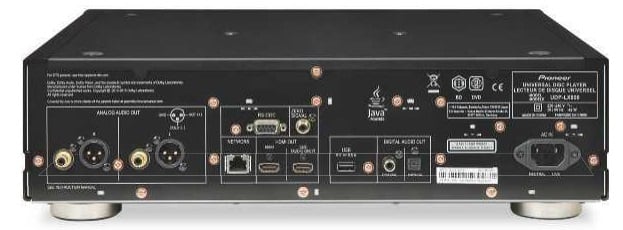
ABOVE: USB-A (not USB-B), front and back, supporting external pen drives/HDDs alongside wired Ethernet. S/PDIF digital outs on coaxial and optical are joined by HDMI (Audio and AV) plus balanced (XLR) and single-ended (RCA) analogue outputs
With Steven Wilson’s Home Invasion live set [Eagle Vision ERBCD5364; 96kHz/24-bit] the ’LX800 may thicken up a little when the music gets really busy, but it shows no lack of conviction when driving a track such as ‘Nowhere Now’. There’s bags of live ambience here, but at the same time real punch and slam in the rhythm section when required.
MEDIA AGNOSTIC
What’s more, it shows no favours to either network playback or music on USB drives, the sound being indistinguishable between the two even when one ups the ante with the free-flowing intricacy of the Elgar and Finzi Violin Concertos played by Ning Feng [Channel Classics CCS 40218; DSD128/5.6MHZ]. The bite of bow on string, the fluidity of the performance and the excellent balance between the soloist and orchestra – all are open for inspection, and a brief listen to the multichannel version via my AV receiver and surround system shows the added ambience and presence the extra speakers can bring.
However, a little definition and detail is traded when playing this way when compared to

LEFT: Partnering remote offers access to disc menus and Pioneer’s Home Menu for complete AV control, inc the three digital (audio) filters
the direct analogue connections to a high-quality amplifier. Of course in a versatile set-up, such as mine, one can make both connections and switch between them at will.
Playing James Greer’s Tokyo No Densha [Musicity 002; 48kHz/24-bit], the ’LX800’s slightly over-analytical sound serves well this assemblage of field recordings and electronica, sweeping the listener into the soundscape of the set’s two long pieces in compelling fashion.
I’m aware that so far I’ve mainly reviewed this Blu-ray player not even as a disc machine, so well does it handle files rather than physical media. However, yes, it is also very good when playing SACD and CD media, bringing to bear those same qualities of insight and detail, allied to that slightly light but always tight and involving presentation.
That makes it an extremely good disc player, even if not to these ears in quite the same league as the stablemate PD-70AE. The latter would be my choice of the two if I didn’t want, or need, the video disc capability also on offer here.
VERDICT
LAB REPORT
Borrowing heavily from the design of its PD-70AE CD/SACD player [HFN May ’18] with its two ESS9026 Pro DACs, the performance of the UDP-LX800 is nigh-on identical, with very minor ‘tweaks’. Once again the player’s THD and noise is largely governed by the balanced analogue stage over the top 20dB of its dynamic range. So, at the maximum 4.3V output, distortion is 0.0012- 0.0235% (20Hz-20kHz) but this drops to 0.0002-0.0006% at -15dBFs and 0.0009-0.0025% at -30dBFs [see Graph 1, below]. High frequency distortion, and noise, is necessarily higher via SACD because of its requantisation noise – amounting to 0.044%/20kHz and 0.055%/30kHz. The response via SACD is also governed by the player’s filtering of this noise, but reaches out to -0.3dB/20kHz, -0.5dB/40kHz, -3.0dB/60kHz, -9.1dB/80kHz and -17.4dB/100kHz (slightly flatter than the PD-70AE).
The response via CD and USB-A digital inputs is determined by your choice of digital filter. The default ‘Sharp’ is a linear phase type offering a modest 58dB of stopband rejection and a response that’s flat to -0.05dB/20kHz, -0.4dB/45kHz and -1.0dB/90kHz with CD/48kHz, 96kHz and 192kHz media, respectively. ‘Short’ and ‘Slow’ are both minimum phase types with no pre-ringing, but trades exaggerated and reduced post- ringing for steep and gentle treble roll-offs, respectively. ‘Short’ extends to -0.1 dB/20kHz while ‘Slow’ is flat to within ±0.1 dB up to 16kHz but then rolls off to -5.0dB/20kHz. Regardless of filter or media, the A-wtd S/N is a wide 113.5dB and low-level linearity good to ±0.1 dB over a 100dB dynamic range. Jitter, at all sample rates, falls within 50-100psec but requantisation noise is clear to see – if inaudible – with SACD [red spectrum, Graph 2].
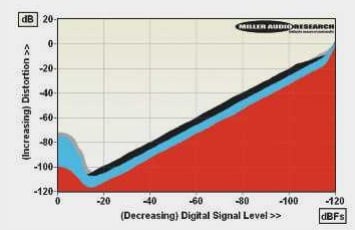
ABOVE: Distortion vs. digital signal level over a 120dB dynamic range – 48kHz/24-bit LPCM (1kHz, red; 20kHz, blue) vs. CD (1kHz, black; 20kHz, grey)
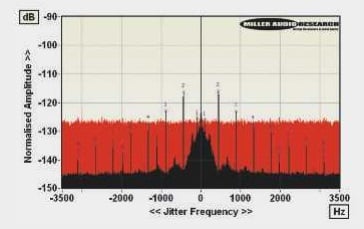
ABOVE: High resolution 48kHz/24-bit jitter spectrum via USB-A (black, with markers) vs. SACD (red)
Pioneer UDP-LX800 specifications
